Вы здесь
Dinosaur Plateau in Kugitang.
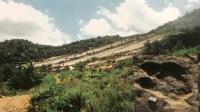
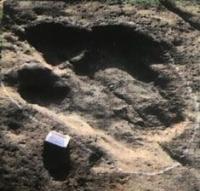
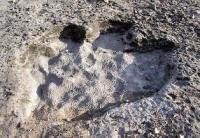
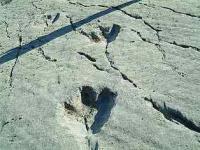
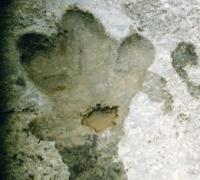
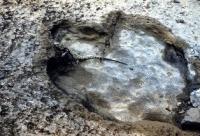
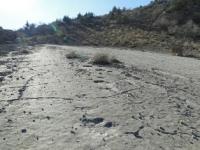
Walk to footprints of dinosaurs in Turkemenistan.
“And seeing that the border of lilac-gray showers
The fiery evening horizon will be tightened
Raising two-pair spreading tusks
So the lagging mastodon roared piteously.
The ground hummed and bent under the running carcass,
And in the dump of dividing, like saw teeth, fangs,
Crunching and squelching in the bloody thick thick,
They gnawed cartilage and vertebrae from the ribs"
"Mahayrodusy". 1911. Mikhail Zenkevich.
Tours to Dinosaur Plateau in Kugitang Mountains.
The Dinosaur Plateau with more than a hundred fossilized footprints of ancient lizards is located at an altitude of 1202 meters above sea level, located on the northern slope in the eastern part of the Kugitang Tau ridge, 13 kilometers to the east and slightly north of the village of Koyten, 48.3 kilometers to the northeast from the village of Karlyuk and 74.5 kilometers northeast of the village of Koytendag in the Koytendag etrap of the Lebap velayat.
The legend says: “The great Alexander was mighty and clever. When he crossed the border of Sogdiana, he put elephants in front of his troops, which, like a ram, destroyed the enemy's formation. However, in the battle that took place on the western slope of Kugitang, the Sogdians behaved courageously. And even the huge elephants did not help Alexander.
In a bloody battle, the Sogdians forced them to flee home. And the battle was so hot that the footprints of Alexander's elephants remained on the surface of the mountain. And since then this place has been called in Turkmen Khojapil-ata (Traces of the elephants of the holy grandfather)”.
This legend, like a magnet, attracts numerous researchers to the western slopes of the Kugitang - the southern continuation of the southwestern spurs of the Gissar ridge. Indeed, in the area of Khojapil-ata, on the surface of the cleavage, 2500 depressed tracks were found, which scientists attribute to the tracks of a dinosaur.
22 lines of 360 tracks were laid in the Sary-Kiya area. This number of footprints of Upper Jurassic dinosaurs has no analogues in the world. In Hodjapilasaurus, the toes are elongated on three-toed legs, the long middle one protrudes slightly forward, the latter is shorter than the first.
Hissarasaurus is a two-legged, but already four-toed dinosaur, the heel is rectangular, wide. The diameter of large footprints of adults is 70 - 80 centimeters, the distance of the stride is 1.5 meters, therefore the growth of dinosaurs was 8 - 12 meters, the length of the body was up to 5 meters, all within 5 - 10 tons.
All these imprints on the unhardened ground are well preserved on the surface of the track site. In all tracks, the toes are more strongly depressed than the heels. This suggests that the animals moved quickly, as if someone was chasing them.
Interesting are other, not very clear, small dents located slightly away from the chains of dinosaur tracks, parallel to them. One of them is very reminiscent of a bare human footprint. Its length is 26 cm. By modern standards, it would correspond to size 43.
However, the find seems incredible. After all, it is known that man or humanoid beings appeared relatively recently. The history of modern man is only a few hundred thousand years old. Before him lived paleanthropes, ancient people, and they were preceded by pyghecanthropy-fawns ”- even more ancient ancestors of man.
Their age is determined by half a million years. Then Australopithecines were discovered and "age" began to be measured in millions of years. Anthropologist Louis Lick on finds in East Africa proved that the most ancient ancestors of people existed more than two and a half million years ago.
The age of the bipedal humanoid creature found by Johnson is approximately three and a half million years. This is the last time limit, which, thanks to science, is known to us about humanoid beings. But where did the man or the humanoid creature come from in Kugitang, because the dinosaurs here are 150 million years old?
In addition, it is known that they all died out suddenly, somewhere at the turn of the Cretaceous and Tertiary periods, about 65 million years ago. The reason for the sudden pestilence is still not known for sure. According to hypotheses, dinosaurs became extinct as a result of global changes in natural conditions, for example, the activation of volcanoes or tectonic movements, or as a result of mammals devouring dinosaur eggs, etc.
There are over eighty hypotheses. But in any case, according to modern science, the path of humans and dinosaurs should not intersect. After all, there are at least 61.5 million years between them. Is not it? In science, in addition to the Kugitang case, several more cases are known when the footprints of dinosaurs and humans met together.
The next glaciation, which led to a sharp change in the climate on Earth, took away their energy base from the intelligent Neanderthals. The preglacial fauna, so completely mastered by them, began to disappear, to die out - thus, energy sources and resources began to disappear.
The agony of a great civilization followed. One by one, the Neanderthals lost their achievements. And, in the end, they began to run wild and die out themselves. Their pitiful remnants scattered across the Earth. And when the glaciation ended, other human races began to dominate the planet.
Against the background of these data, it can be assumed that representatives of the "intelligent Neanderthals", leaving their Antarctic archipelago, already covered with an ice shell, took with them information about its outlines, and after many generations they have come down to us in the form of maps of Piri Reis and Phineus.
With the help of Cabrera's hypothesis, it is easy to explain the traces of a humanoid creature that hunted dinosaurs in Kugigang 150 million years ago and the figures "painted" on the surface of Ustyurt.
Geographic coordinates of dinosaur footprints in the Kugitang tau mountains: N37 ° 56'01.98 "E66 ° 37'46.07"
Authority:
"Religious and Spiritual Monuments of Central Asia". Author M. Khashimov. Saga Publishing House, 2001







